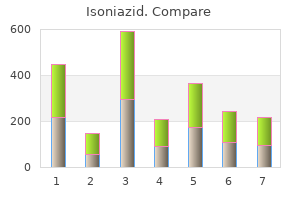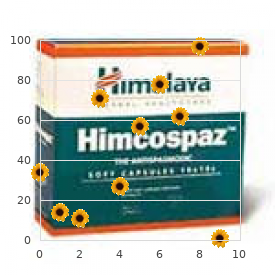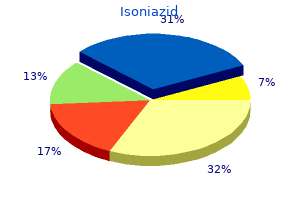"Generic 300 mg isoniazid visa, symptoms norovirus".
By: I. Jose, M.B. B.CH. B.A.O., Ph.D.
Deputy Director, University of Nevada, Reno School of Medicine
Some of the neuroprotecitve treatment trails arte Non steroidal anti-inflammatory agents Estrogens replacement therapy in post menopausal women Selegilline therapy delays the need for levodopa therapy by 9 -12 months in newly diagnosed patients medicine 7253 pill isoniazid 300 mg visa. Studies demonstrated that patients who remain on Selegilline for 7 yrs experienced slower motor decline symptoms dust mites discount isoniazid on line. Therapy of non motor symptoms Insomnia due to nocturnal akinesia: treated with night time supplemental dose of Carbidopa /levodopa Depression: Responds to anti depressants like Amitriptyline Psychotic patients: first remove anticholinergics and amantadine if the patient is taking treatment zoster purchase discount isoniazid line. If still the patient has psychotic symptoms and signs medications ritalin purchase isoniazid 300mg without a prescription, start antipsychotics with minimal extrapyramidal side effects. Other movement disorders Hyperkinetic disorders: these are disorders associated with increased movement. Tremor a) Benign essential tremor is characterized by posture related 5-9 Hz oscillation of hands and forearms that impairs performance of fine motor tasks. Myoclonus Definition: a brief, lightning-like contraction of a muscle or group of muscles. Common hiccup (singultus) is a form of myoclonus affecting the diaphragmatic muscles. Action myoclonus: is a myoclonus that increases with intended movements, It occurs typically after brain injury; Palatal myoclonus is a continuous, rhythmic contraction of posterior pharyngeal muscles. Tics Brief, rapid, simple or complex involuntary movements, which are stereotypical and repetitive, but not rhythmic. Complex motor tics often resemble fragments of normal behaviour such as touching, smelling and jumping. Simple phonic tics include throat clearing, sniffing and grunting and complex phonic tics include the repetition of words and coprolalia. Treatment Education of patients and their family Drugs: Clonidine, Haloperidol 543 Internal Medicine 3. Chorea and Athetosis Definition: Chorea: is brief, purposeless involuntary movements of the distal extremities and face, which may merge imperceptibly into purposeful or semi purposeful acts that mask the involuntary motion. Chorea gravidarum It is choreiform movement occurring during pregnancy, often in patients with a history of rheumatic fever. Chorea usually begins during the first trimester and resolves spontaneously by or after delivery. Treatment consists of sedation with barbiturates, because other drugs may harm the fetus. Hemiballismus It is violent, continuous proximal limb flinging movements confined to one side of the body, usually affecting the arm more than the leg. It is caused by a lesion, usually an infarct, in the region of the contralateral sub-thalamic nucleus of Luys. Differential diagnosis includes acute hemichorea, usually due to tumor or infarct of the caudate nucleus, and focal seizures. It is an autosomal dominant disorder characterized by choreiform movements and progressive intellectual deterioration, usually beginning in middle age. Motor manifestations: flicking movements of the extremities, a lilting gait, motor impersistence (inability to sustain a motor act, such as tongue protrusion), facial grimacing, ataxia, and dystonia. Disorder is always progressive; patients ultimately lose physical and mental abilities to care for themselves. Dystonia Definition: Sustained abnormal posture and disruptions of ongoing movement, resulting from alterations in muscle tone; it is classified as generalized, focal or segmental: Generalized dystonia (dystonia musculorum deformans) It is a rare progressive syndrome characterized by movements that result in sustained, often bizarre postures. Symptoms usually begin in childhood with inversion and plantar fixation of the foot while walking. Rarely, dystonic movements spread to an adjacent region (segmental dystonia), and even more rarely, the process generalizes. Peripheral neuropathy Definition: A general term indicating peripheral nerve disorder of any cause. The type of symptoms and signs: Sensory, Motor, Autonomic, Or any combination 2. Distribution Mononeuropathy: single nerve affected Multiple mononeuropathy(mononeuritis multiplex): two or more nerves in separate areas affected Polyneuropathy: many nerves simultaneously affected 3. Mononeuropathy: Trauma: most common cause of localized injury to single nerve Focal neuropathy: violent muscular activity, forcible overextension of joint, repeated small traumas Pressure or entrapment paralysis: affects superficial nerves at bony prominences or at narrow canals; also from tumors, bony hyperostosis, casts, crutches, prolonged cramped postures.
Pituitary excess causes encephalopathy by hyperfunction of the pituitary-adrenal axis medicine hat mall cheap 300mg isoniazid. Cancer Diffuse encephalopathy leading to delirium symptoms rotator cuff injury cheap isoniazid 300mg online, stupor bad medicine 1 isoniazid 300mg discount, or coma is frequently seen in patients with disseminated cancer 400 medications generic 300 mg isoniazid free shipping. This 76-year-old male had been hospitalized for treatment of rectal carcinoma when he suddenly complained of headache, visual blurring, diplopia, and confusion. Surgery revealed a necrotic lesion with a few cells that probably represented a pituitary adenoma. Multiple small strokes Infections Viral Fungi Bacteria Side effects of therapy Radiation Chemotherapy Metabolic Nutritional apoplexy. The acute form begins hours to days after delivery with signs of acute adrenal insufficiency (see above). In the past, symptoms began in the hospital before the patient went home, but because of the advent of short obstetric stays, most patients return home and then present to an emergency department with hypotension,tachycardia,hypoglycemia,fatigue, nausea, and vomiting; unrecognized, the disease is fatal. However, when a single cause was identified, multiple brain metastases were the most common. In some cases, the metastases are leptomeningeal and may be discovered only by lumbar puncture. Treatment with chemotherapy had produced a severe pancytopenia, which had led to pneumonia. In addition, he suffered from renal failure and required intermittent hemodialysis. Early in the afternoon he began hemodialysis, but he became hypotensive and hemodialysis was stopped. He was noted early in the evening to be markedly obtunded, with the right eye slightly deviated outward and upward. With vigorous stimuli, however, he could be aroused to say his name and to identify Memorial Hospital. In the resting position, the left eye was straight ahead and the right eye was slightly externally and superiorly deviated. Laboratory abnormalities that morning had included a white blood cell count of 1,100/mm3, a hemoglobin of 9. Because of the small pupils and slow and shallow respiration, despite the pneumonia, the patient was given 0. The pupils dilated to 6 mm, respirations went from 8 to 24 per minute, and he became awake and alert, complaining of the low back pain for which he had been given the drug that morning. Comment: the clues to opioid overdosage in this patient were the small pupils and the shallow, irregular respirations despite pneumonia. Furthermore, the long action of levorphanol induced a relapse the next morning after the effects of the naloxone had worn off. When stimulated vigorously she would answer with her name, but could not answer other questions or follow commands. Pupils were 2 mm bilaterally, with roving eye movements and full responses to oculocephalic maneuvers. She was treated with dexamethasone and whole brain radiation therapy, resulting in rapid clearing of her cognitive function. Intraventricular chemotherapy with methotrexate and cytosine arabinoside was initiated. When she died of a pulmonary embolus 18 months later, autopsy revealed no evidence of residual cancer in the brain. The loss of several tendon reflexes in this setting is a critical clue to the diagnosis. Radiologic evaluation may show nothing, or it may reveal superficial tumor implants along the surface of the brain, the meninges, or the spinal roots. Agents causing delirium or coma may include (1) medicinal agents prescribed but taken in overdose, (2) medicinal agents procured illicitly. However, patients who are stuporous but arousable may deny drug ingestion and, if comatose, no history may be available at all.
Cheap isoniazid 300mg overnight delivery. Withdrawal Symptoms of Smoking.

Respiratory alkalosis Hepatic failure* Sepsis* Pneumonia Anxiety (hyperventilation syndrome) C symptoms precede an illness buy isoniazid on line amex. Acute (uncompensated) Sedative drugs* Brainstem injury Neuromuscular disorders Chest injury Acute pulmonary disease 2 section 8 medications discount 300mg isoniazid. Acid-Base Changes Accompanying Hyperventilation During Metabolic Encephalopathy Respiration is the first and most rapid defense against systemic acid-base imbalance administering medications 8th edition generic 300mg isoniazid amex. Hypoxia sensitizes peripheral chemoreceptors and activates central chemoreceptors medicine 257 buy isoniazid 300 mg low cost, but under most circumstances carbon dioxide levels, which are linked to blood pH, are more important in determining respiration (see Chapter 2). Metabolic acidosis and respiratory alkalosis are differentiated by blood biochemical analyses. Respiratory compensation for metabolic acidosis is a normal brainstem reflex response and, hence, occurs in most cases of metabolic acidosis. Mixed primary metabolic acidosis and primary respiratory alkalosis (which persists after the acidotic load is removed) also occurs in several conditions, particularly salicylate toxicity and hepatic coma. A diagnosis of mixed metabolic abnormality can be made when the degree of respiratory or metabolic compensation is excessive. In any given patient, a quick and accurate selection can and must be made from among these disorders. Diabetes and uremia are diagnosed by appropriate laboratory tests, and diabetic acidosis is confirmed by identifying serum ketonemia. It is important to remember that severe alcoholics without diabetes occasionally can develop ketoacidosis after prolonged drinking bouts. Anoxic lactic acidosis would be suspected only if anoxia or shock was present, and even then severe anoxic acidosis is relatively uncommon. Although laboratory tests can identify and quantify the ingested agents, these tests are not usually immediately available (see Chapter 7). However, the toxins are osmotically active and measurement of serum osmolality can detect the presence of an osmotically active substance, indicating exposure to a toxic agent. Intravenous bicarbonate is indicated to treat hyperkalemia and to help clear acidic toxins from cells. Neurogenic pulmonary edema and central neurogenic hyperventilation may also cause respiratory alkalosis in patients with metabolic stupor or coma. As is true with metabolic acidosis, these usually can be at least partially separated by clinical examination and simple laboratory measures. Salicylate poisoning causes a combined respiratory alkalosis and metabolic acidosis that lowers the serum bicarbonate disproportionately to the degree of serum pH elevation. Salicylism should be suspected in a stuporous hyperpneic adult if the serum pH is normal or alkaline, there is an anion gap, and the serum bicarbonate is between 10 and 14 mEq/L. Salicylism in children lowers serum bicarbonate still more and produces serum acidosis. A bedside laboratory test can rapidly establish a diagnosis of salicylate intoxication,27 although usually in an awake patient the positive history and the presence of respiratory alkalosis are sufficient. A single serum salicylate measurement may be somewhat misleading, particularly if the patient has taken enteric-coated tablets that may delay absorption. Therefore, in a patient with a suspected salicylate overdose, careful measurements should be done every 3 hours until levels have peaked. The ingestion of sedative drugs in addition to salicylates may blunt the hyperpnea and lead to metabolic acidosis, a picture that may mislead the examiner. Salicylates directly activate the respiratory centers of the brainstem, although the mechanism is not known. Acetaminophen poisoning, more common than salicylate poisoning, may cause either metabolic acidosis (lactic acidosis) or respiratory alkalosis resulting from its hepatic toxicity (see below). Urinary alkalization helps promote excretion of the drug; hemodialysis may be necessary if there is renal failure.


While this often presents with a headache and loss of consciousness medicine administration buy isoniazid 300mg without prescription, it has a relatively benign prognosis symptoms 5 days before missed period order isoniazid. In part this is because the cerebellum occupies a large portion of this compartment medicine lake mn buy isoniazid with visa, but in part because the brainstem is so small that an expanding mass lesion often does more damage by tissue destruction than as a compressive lesion 7 medications that cause incontinence purchase cheap isoniazid line. Cerebellar Hemorrhage About 10% of intraparenchymal intracranial hemorrhages occur in the cerebellum. Increasing numbers of reports in recent years indicate that if the diagnosis is made promptly, many patients can be treated successfully by evacuating the clot or removing an associated angioma. Hemorrhages in hypertensive patients arise in the neighborhood of the dentate nuclei; those coming from angiomas tend to lie more superficially. Both types usually rupture into the subarachnoid space or fourth ventricle and cause coma chiefly by compressing the brainstem. Subsequent reports from several large centers have increasingly emphasized that early diagnosis is critical for satisfactory treatment of cerebellar hemorrhage, and that once patients become stuporous or comatose, surgical drainage is a near-hopeless exercise. Messert and associates described two patients who had unilateral eyelid closure contralateral to the cere- bellar hemorrhage, apparently as an attempt to prevent diplopia. When he arrived in the hospital emergency department he was unable to sit or stand unaided, and had severe bilateral ataxia in both upper extremities. He was a bit drowsy but had full eye movements with end gaze nystagmus to either side. There was no weakness or change in muscle tone, but tendon reflexes were brisk, and toes were downgoing. By the time the patient returned to the emergency department he had no oculocephalic responses, and breathing was ataxic. Shortly afterward, he had a respiratory arrest and died before the neurosurgical team could take him to the operating room. Mutism, a finding encountered in children after operations that split the inferior vermis of the cerebellum, occasionally occurs in adults with cerebellar hemorrhage. Similar abnormalities may persist if there is damage to the posterior hemisphere of the cerebellum, even following successful treatment of cerebellar mass lesions. The scan identifies the hemorrhage and permits assessment of the degree of compression of the fourth ventricle and whether there is any complicating hydrocephalus. Our experience with acute cerebellar hemorrhage points to a gradation in severity that can be divided roughly into four relatively distinct clinical patterns. With larger hematomas, occipital headache is more prominent and signs of cerebellar or oculomotor dysfunction develop gradually or episodically over 1 to several days. However, the condition requires extremely careful observation until one is sure that there is no progression due to edema formation, as patients almost always do poorly if one waits until coma develops to initiate sur- gical treatment. The most characteristic and therapeutically important syndrome of cerebellar hemorrhages occurs in individuals who develop acute or subacute occipital headache, vomiting, and progressive neurologic impairment including ipsilateral ataxia, nausea, vertigo, and nystagmus. Parenchymal brainstem signs, such as gaze paresis or facial weakness on the side of the hematoma, or pyramidal motor signs develop as a result of brainstem compression, and hence usually are not seen until after drowsiness or obtundation is apparent. The appearance of impairment of consciousness mandates emergency intervention and surgical decompression that can be lifesaving. About one-fifth of patients with cerebellar hemorrhage develop early pontine compression with sudden loss of consciousness, respiratory irregularity, pinpoint pupils, absent oculovestibular responses, and quadriplegia; the picture is clinically indistinguishable from primary pontine hemorrhage and is almost always fatal. The degree of fourth ventricular compression is divided into three grades depending on whether the fourth ventricle is normal (grade 1), is compressed (grade 2), or is completely effaced (grade 3). Grade 1 or 2 patients who are fully conscious are carefully observed for deterioration of level of consciousness. If grade 2 patients have impaired consciousness with hydrocephalus, a ventricular drain is placed. In grade 3 patients and grade 2 patients who have impaired consciousness without hydrocephalus, the hematoma is evacuated. No grade 3 patients with a Glasgow Coma Score less than 8 experienced a good outcome.


